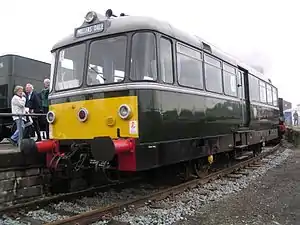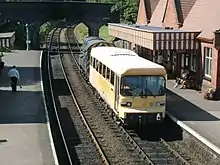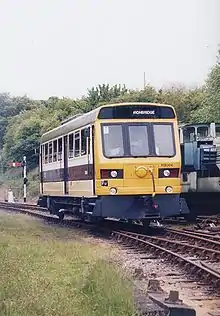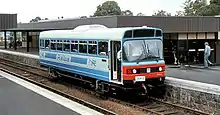British Rail railbuses
British Rail produced a variety of railbuses, both as a means of acquiring new rolling stock cheaply, and to provide economical services on lightly-used lines.
| British Rail Railbuses | |
|---|---|
 Waggon- und Maschinenbau railbus no. 79964 at York Railfest exhibition on 3 June 2004. This vehicle is preserved on the Keighley and Worth Valley Railway. | |
| In service |
|
| Capacity | 46–56 seats |
| Operator(s) | |
Terminology
Railbuses are a very lightweight type of railcar designed specifically for passenger transport on little-used railway lines. As the name suggests, they share many aspects of their construction with a bus, usually having a bus body, or a modified bus body, and having four wheels on a fixed wheelbase, instead of on bogies. Some, but not all, of the units have been equipped for operation as diesel multiple units.
First generation

In the late 1950s, British Rail tested a series of small railbuses, produced by a variety of manufacturers, for about £12,500 each[1] (£261,000 at 2014 prices).[2] These proved to be very economical (on test the Wickham bus was about 9 mpg‑imp (0.31 L/km)),[3] but also somewhat unreliable. The lines they worked on were mainly closed during the Beeching Cuts and, being non-standard, they were all withdrawn in the mid-1960s, before being allocated TOPS classifications.
In addition to these railbuses, BR ordered three for departmental (non-revenue earning) service. The full list of passenger and departmental units is set out below.
| Lot No. | Manufacturer | Diagram | Qty | Fleet numbers | Service life | Length over body | Seats | Notes |
|---|---|---|---|---|---|---|---|---|
| 30483 | Bristol / Eastern Coach Works | 610 | 2 | Sc79958–79959 | 1958–1966 | 42 ft 4 in (12.90 m) | 56 | |
| 30482 | Waggon- und Maschinenbau GmbH Donauwörth railbus | 611 | 5 | E79960–79964 | 1958–1967 | 45 ft 10 in (13.97 m) | 56 | |
| 30481 | D Wickham & Co | 612 | 5 | Sc79965–79969 | 1958–1966 | 38 ft 0 in (11.58 m) | 48 | |
| 30480 | Park Royal Vehicles | 613 | 5 | Sc79970, 79974 M79971–79973 | 1958–1968 | 42 ft 0 in (12.80 m) | 50 | |
| 30479 | AC Cars | 614 | 5 | W79975–79978 Sc79979 | 1958–1968 | 36 ft 0 in (10.97 m) | 46 | |
| D Wickham & Co | 1 | RDB999507 Elliot | 1958–1997 | |||||
| Drewry Car Co. | 2 | RDB998900-998901 | 1950–1990 |

Engines:[4]
Second generation


British Rail returned to the idea of railbuses from the mid-1970s, and a prototype four‐wheel vehicle was developed jointly by British Leyland and the British Rail Research Division. Several single and two-car railbuses were built and tested, in co-operation with Leyland (hence the generic term for these vehicles as LEV (Leyland Experimental Vehicle) railbuses). The first three single-car prototypes were essentially Leyland National bus bodies mounted on a modified HSFV1 four-wheeled rail chassis. The prototype two-car railbus was allocated Class 140 and is dealt with on that page, but the prototype single-car railbuses were not classified and are set out in the table below:
| Number | Identity | Builder | Introduced | Withdrawn |
|---|---|---|---|---|
| RDB 975874 | LEV1 | Leyland/BREL Derby | 1978 | 1987 |
| — | LEV2/R3 | Leyland/Wickham | 1980 | 19?? |
| RDB 977020 | R3 | Leyland/BREL Derby | 1981 | 1990 |
| — | RB004 | Leyland/BREL Derby | 1984 | 19?? |
| — | RB002 | Leyland/BREL Derby | 1984 | 19?? |
In 1978, tests were carried out with a modified double-ended Leyland National bus body placed on an unpowered wagon chassis derived from HSFV1, this was LEV1 (Leyland Experimental Vehicle 1). Whilst in its unpowered state this vehicle never left the Railway Technical Centre in Derby. In 1979 a powertrain was added to LEV1,[5] the engine being a Leyland 510 diesel, and the transmission a mechanical type with self-changing gears.
Even though some of these vehicles carried numbers in the departmental coach series, they were used in ordinary passenger service. LEV1 was initially tested in passenger service in East Anglia, and then elsewhere, before being temporarily exported to the US in the early 1980s. LEV1 was withdrawn and transferred to the National Railway Museum in 1987, [6] before moving to the North Norfolk Railway, where it underwent restoration, then moving in 2012 to the NRM's Shildon site.
LEV2, built especially for the US at 50 ft (15.3 m), was a stretched version of LEV1 and sometimes known as R3. Following export around 1981, it was used on an experimental extension of MBTA (Boston) commuter service to Concord, New Hampshire. When that experiment was ended in 1981 the LEV2 was sold to Amtrak for use on the Northeast Corridor, but it was quickly put out of service after an accident at a crossing. It was subsequently sold to the Steamtown Museum in Scranton, Pennsylvania for use as a shuttle,[7] but was damaged during repair and sold for scrap. It was bought from the scrap dealer by the Durbin & Greenbrier Valley Railroad, a tourist railroad in West Virginia, and later sold to the Connecticut Trolley Museum, where it remains to this day.[8]
In 1985, SEPTA tested a British Rail railbus on the Fox Chase line as part of an effort to restore service to Newtown. Though the trial runs were relatively successful, ride quality was lackluster, and SEPTA never purchased the railbuses.[9]
Similarly, the BR version of R3 (RDB977020) was run in service on BR for a few years before eventually being sold to Northern Ireland Railways in late 1982 where it was converted to the 5 ft 3 in (1,600 mm) Irish gauge. R3, also known as RB003, was withdrawn in 1990 and preserved, initially at the Ulster Transport Museum, then in 2001 at the Downpatrick & County Down Railway.[10]
Another version, RB004 was built at Derby in 1984. The body was built at the Leyland plant at Workington and BREL Derby C&W were responsible for the underframe and final assembly. This is preserved in running order at the Waverley Route Heritage Association site at Whitrope.

Yet another BREL-Leyland product from c1984, RB002, was exported as a demonstrator, going to the US and Canada, then Denmark and Sweden. Afterwards, the RB002 was used in the Netherlands and Germany for a demonstration of light rail vehicles on the then defunct railway between Enschede and Gronau.[11][12] It returned to the UK, having gained the nickname, "The Denmark", and was used as a classroom/office by BREL for a while and somehow it too ended up in Ireland. Its present location is believed to be at the now‐closed standard gauge Riverstown Old Corn Railway near Dundalk in Ireland but it is understood to be in a poor state of repair.[13]
These railbuses were sent abroad in the hope of gathering export orders, but they never transpired.
In addition, there was an experiment with a loco-hauled Leyland-built vehicle. A National bus-type body was placed on the 63-foot (19 m) underframe from Mk1 BCK coach number 21234. This was numbered RDB 977091 and was run in normal service around the London Midland region alongside ordinary coaching stock until withdrawn as being unsuitable. The only direct connection with railbuses was the use of the same type of bus-based body shell to reduce costs to a minimum. The coach is now preserved at the Llanelli and Mynydd Mawr Railway.
Pacers
As a result of these tests, British Rail ordered a series of two- and three-car railbuses, which became known as Pacers (or Skippers in the Western Region), and were allocated TOPS Classes 141–144. The next generation of Sprinter units were based on conventional railway design and bogie-mounted bodies.
Routes
.JPG.webp)
Lines regularly served by railbuses include:
Scotland
- Ayr – Dalmellington 1959–1964[14]
- Craigendoran – Arrochar 1959[15]–1964[14]
- Darvel 1959–1964[14]
- Devon Valley 1959–1964[14]
- Falkirk – Grangemouth 1967–1968[14]
- Gleneagles – Crieff / Comrie 1958[16]–1964[17]
- Kilmarnock – Ardrossan / Ayr 1962-1964[14]
- Larbert – Alloa 1967–1968[14]
- Lugton – Beith 1959–1962[14]
- Speyside 1958–1965[14]
Midlands
- Bedford – Northampton / Hitchin 1958–1959[14]
- Millers Dale – Buxton 1966–1967[14]
Western
- Bodmin – Wadebridge 1964[19]–1967[20]
- Kemble – Cirencester Town and Kemble-Tetbury 1959[21]–1964[22]
- Yeovil Junction – Yeovil Town 1964[23]–1966[24] – Pen Mill 1966[25]
Preservation
A number of the BR railbuses, both first and second generation examples have survived into preservation, as follows:
| Vehicle no. | Builder | Year built | Location | Comments |
|---|---|---|---|---|
| First generation | ||||
| 79960 | Waggon und Maschinenbau | 1958 | Ribble Steam Railway | Formerly North Norfolk Railway |
| 79962 | Waggon und Maschinenbau | 1958 | Keighley and Worth Valley Railway | — |
| 79963 | Waggon und Maschinenbau | 1958 | East Anglian Railway Museum | Formerly North Norfolk Railway, now on loan |
| 79964 | Waggon und Maschinenbau | 1958 | Keighley and Worth Valley Railway | — |
| 79976 | AC Cars | 1958 | Great Central Railway | Purchased in 1968 without its engine and moved to Bristol and then Bleadon and Uphill museum.[26] Since then it has moved to Bodmin & Wenford Railway, County School railway station, Colne Valley Railway and then Great Central Railway, before moving to Nemesis Rail where it is stored as a sheeted-over carcass.[27] |
| 79978 | AC Cars | 1958 | Colne Valley Railway | Sold to North Yorkshire Moors Railway in 1968[28] It was then on the Kent & East Sussex from 1979 to 1984, when it moved to Colne.[29] |
| RDB999507 | Wickham | 1958 | Previously Middleton Railway – moved to Lavender Line 2009 | Elliot High-speed track-recording unit |
| RDB998901 | Drewry Car Company | 1950 | Middleton Railway | Overhead-line inspection car |
| Second generation | ||||
| RDB975874 | Leyland/BREL Derby | 1978 | Wensleydale Railway | LEV 1 |
| LEV2 | Leyland/BREL Derby | 1980 | Connecticut Trolley Museum | There is a project to repatriate LEV2 |
| RDB977020 | Leyland/BREL Derby | 1980 | Downpatrick & County Down Railway in Northern Ireland | LEV3 aka RB3. Has been regauged to 5'3” |
| RB002 | Leyland/BREL Derby | 198? | Riverstown Old Corn Railway? near Dundalk, Ireland | RB002 aka The Denmark |
| RB004 | Leyland/BREL Derby | 1984 | Currently at the Whitrope Siding (arrived 31 May 2012) | Owned by Northumbria Rail Ltd. and The Railbus Trust. Moved from Telford Steam Railway to Llangollen Railway 20 May 2011 and then to Midland Railway Centre 19 August 2011 |
Additionally, AC Cars railbus 79979 was preserved. It was the first of the railbuses to be delivered and spent all its working life in Scotland. In 1968 it was moved to Craigentinny, where the chassis was scrapped and it was used as a battery store. It was moved to make way for the TMD in 1977 and the grounded body sold to the Strathspey Railway in 1977.[26] It was scrapped by MC Metals, Glasgow, in 1990.[30][31]
See also
References
- Hansard RAILWAYS (DISUSED BRANCH LINES) debate 23 June 1958 p. 208
- "Bank of England inflation calculator". Archived from the original on 6 October 2014. Retrieved 7 September 2015.
- Railway Magazine November 1958 p. 800
- ABC of British Railways Locomotives. Ian Allan. Winter 1962–63. pp. 316–317.
- Gilchrist, A. O. (2009) [2006]. "A history of engineering research on British Railways" (PDF). Working Papers in Railway Studies. Institute of Railway Studies and Transport History (10): 54. ISSN 1368-0706. Retrieved 24 January 2014.
- Railway Magazine. April 1987. p. 252. Missing or empty
|title=(help) - Alves, John (15–28 February 1995). Kelly, Peter (ed.). "Heritage in damage across the Atlantic?". Letters. RAIL. No. 246. pp. 26–27. ISSN 0953-4563.
I 'rediscovered' LEV2 at Scranton, Pennsylvania at the back of Steamtown National Historic Site, hidden from all visitors, in 1990 ... it derailed on the platform line and chewed up the wooden edge of the platform all the way along.
- Cosgro, Matt. "Nashua City Station Railroad History". www.nashuacitystation.org. Retrieved 24 January 2014.
- Woodland 2003, p. 26
- Marsden, Colin (2008). Second Generation DMUs. Ian Allan. p. 12. ISBN 978-0860936244.
- NVBS: Op de Rails: Nieuwsberichten. 3-1985
- NVBS: Op de Rails, W. Miedema: BOREG, Spoorwegmaatschappij voor één dag? 11-1985
- Bulletin Pacerpreservation Society Archived 14 July 2014 at the Wayback Machine
- Tolson, T. M. (January 1968). "Too little, too light, too late". Railway Magazine. Retrieved 20 May 2017.
- "page 625". Railway Magazine. September 1961. Retrieved 20 May 2017.
- Mackay, Stuart. "AC Cars Railbus Scottish Arrival". www.railcar.co.uk. Retrieved 20 May 2017.
- "Locomotive notes – Scottish Region". Railway Magazine. October 1964. Retrieved 20 May 2017.
- BR Atlas and Gazetteer p. 11 D4
- "Change for Bodmin North". Railway Magazine. January 1965. Retrieved 20 May 2017.
- "Cornish Conclusion". Railway Magazine. April 1967. Retrieved 20 May 2017.
- Mackay, Stuart. "WR Services Begin". www.railcar.co.uk. Retrieved 20 May 2017.
- Tolson, John M. (October 1964). "End of an experiment". Railway Magazine. Retrieved 20 May 2017.
- "Yeovil under snow". Railway Magazine. March 1965. Retrieved 20 May 2017.
- Mackay, Stuart. "AC Cars Railbus ScR & WR Moves". www.railcar.co.uk. Retrieved 20 May 2017.
- "Yeovil services altered". Railway Magazine. November 1966. Retrieved 20 May 2017.
- Basil Hancock, Murray Brown (August 1979). "Railbuses Extant". Railway Magazine. Retrieved 20 May 2017.
- "79976". preserved.railcar.co.uk. Retrieved 20 May 2017.
- "Railbus to Grosmont". Railway Magazine. October 1968. Retrieved 20 May 2017.
- "79978". preserved.railcar.co.uk. Retrieved 20 May 2017.
- "Traction News". Rail (138): 50. December 1990.
- "AC railbus 79979". Railcar Association website. Archived from the original on 30 August 2008.
External links
| Wikimedia Commons has media related to British Rail railbuses. |
- AC Cars Railbus
- EM2 Locomotive Society – owners of Drewry railcar DB998901.
- Old Dalby Test Track site – Pictures of the Drewry car RDB998901 in action at BR's test track
- Wickham Railbus Group – owners of Wickham railbus DB999507.
- Train Testing site – Pictures of the testing and travels of the early railbuses
- Train Testing site – Pictures of LEV1 in the US
- departmentals.com
- The Railbus Trust – Working to protect the future of Single Car Railbuses and Second Generation DMU prototypes.